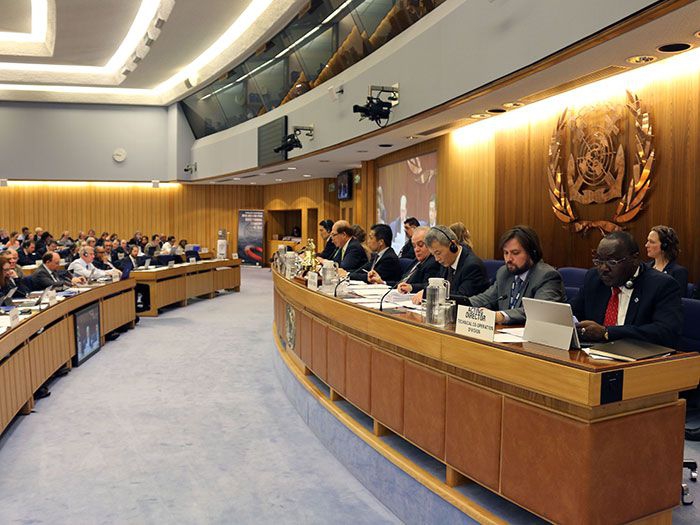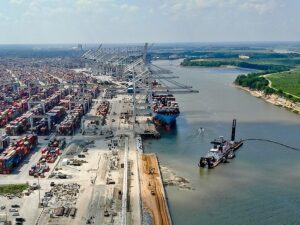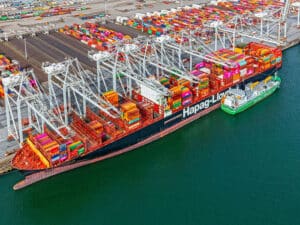
IMO’s MEPC agrees GHG reduction strategy for shipping
Written by Nick Blenkey
APRIL 13, 2018 — IMO’s Maritime Environment Protection Committee has agreed an initial greenhouse gas (GHG) emissions reduction strategy that requires international shipping to reduce total annual GHG emissions by at least 50% by 2050, compared to 2008 levels, and to peak emissions as soon as possible.
Peter Hinchliffe, the Secretary General of the International Chamber of Shipping, said, “This is a ground breaking agreement – a Paris Agreement for shipping – that sets a very high level of ambition for the future reduction of CO2 emissions. We are confident this will give the shipping industry the clear signal it needs to get on with the job of developing zero CO2 fuels, so that the entire sector will be in a position to decarbonize completely, consistent with the 1.5 degree climate change goal.”
He added “The agreed IMO objective of cutting the sector’s total GHG emissions by at least 50% before 2050, as part of a continuing pathway for further reduction, is very ambitious indeed, especially when account is taken of current projections for trade growth as the world’s population and levels of prosperity continue to increase.”
ICS acknowledges that some governments would have preferred to see the adoption of even more aggressive targets, but argues that a 50% total cut by 2050 can realistically only be achieved with the development and very widespread use of zero CO2 fuels. ICS believes that if this 50% goal is successfully met, the wholesale switch by the industry to zero CO2 fuels should therefore follow very swiftly afterwards.
ICS says that the efficiency goal that has been agreed by IMO Member States for the sector as a whole – a 40% improvement by 2030, compared to 2008, and a 50-70% improvement by 2050 – is also extremely ambitious but probably achievable. But only if governments recognise the enormity of this challenge and facilitate the rapid development of new technologies and fuels.
Mr. Hinchliffe remarked that “The industry is very encouraged by the willingness of governments, on all sides of the debate, to co-operate and move to a position that demonstrates unequivocally that IMO is the only body that can meaningfully address the CO2 emissions of international shipping.”
ICS says it hopes the IMO agreement will be “sufficient to discourage those who mistakenly advocate regional measures which, as well being very damaging to global trade, would not be effective in helping the international shipping sector to further reduce its total CO2 emissions, which are currently about 8% lower than in 2008 despite a 30% increase in maritime trade.”
As a result of the IMO agreement, ICS now expects discussions at IMO to begin in earnest on the development of additional CO2 reduction measures, including those to be implemented before 2023.
Not everyone is quite as happy with the agreement as the ICS. The Environmental Defense Fund (EDF) says that, in fact, the quantified target is not in line with the Paris Agreement and that the target “falls short of the pleas from small island nations, which are the most vulnerable to the damaging effects of climate change, and the calls of EU Member States and international NGOs, including the Environmental Defense Fund, for a target that would be more in line with the Paris Agreement’s goals of a 70-100% emissions reduction by 2050. However, the target is backed by a pledge to peak shipping emissions as soon as possible and EDF is committed to promoting effective policies and measures to help reduce the shipping sector’s climate impacts.”
“The shipping sector’s greenhouse gas emissions reduction target represents an important step forward,” said Aoife O’Leary, Legal Analyst, EDF Europe. “The IMO has been talking about climate change for twenty years but the strategy agreed this week marks the beginning of a focused debate about the policies and measures that will help the shipping sector modernize and regain the status of a clean and efficient mode of transport. The target falls short on ambition, but should be sufficient to drive policy development and consequently investment in clean fuels and technology. EDF remains committed to working with stakeholders including those in the industry to find the ways that will work in order to peak shipping emissions as soon as possible.”
IMO BRIEFING
You can read an IMO briefing on the strategy HERE
Among other things, it says that the strategy includes:
Vision:
IMO remains committed to reducing GHG emissions from international shipping and, as a matter of urgency, aims to phase them out as soon as possible in this century.
Levels of ambition
The Initial Strategy identifies levels of ambition for the international shipping sector noting that technological innovation and the global introduction of alternative fuels and/or energy sources for international shipping will be integral to achieve the overall ambition. Reviews should take into account updated emission estimates, emissions reduction options for international shipping, and the reports of the Intergovernmental Panel on Climate Change (IPCC ). Levels of ambition directing the Initial Strategy are as follows:
1) carbon intensity of the ship to decline through implementation of further phases of the energy efficiency design index (EEDI) for new ships
to review with the aim to strengthen the energy efficiency design requirements for ships with the percentage improvement for each phase to be determined for each ship type, as appropriate;
2) carbon intensity of international shipping to decline
to reduce CO2 emissions per transport work, as an average across international shipping, by at least 40% by 2030, pursuing efforts towards 70% by 2050, compared to 2008; and
3) GHG emissions from international shipping to peak and decline
to peak GHG emissions from international shipping as soon as possible and to reduce the total annual GHG emissions by at least 50% by 2050 compared to 2008 whilst pursuing efforts towards phasing them out as called for in the Vision as a point on a pathway of CO2 emissions reduction consistent with the Paris Agreement temperature goals.





Leave a Reply
You must be logged in to post a comment.